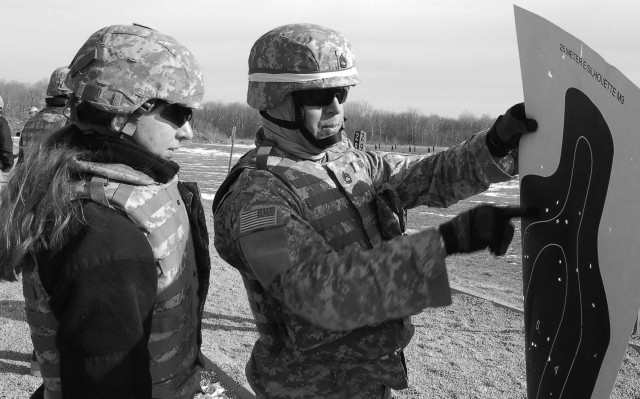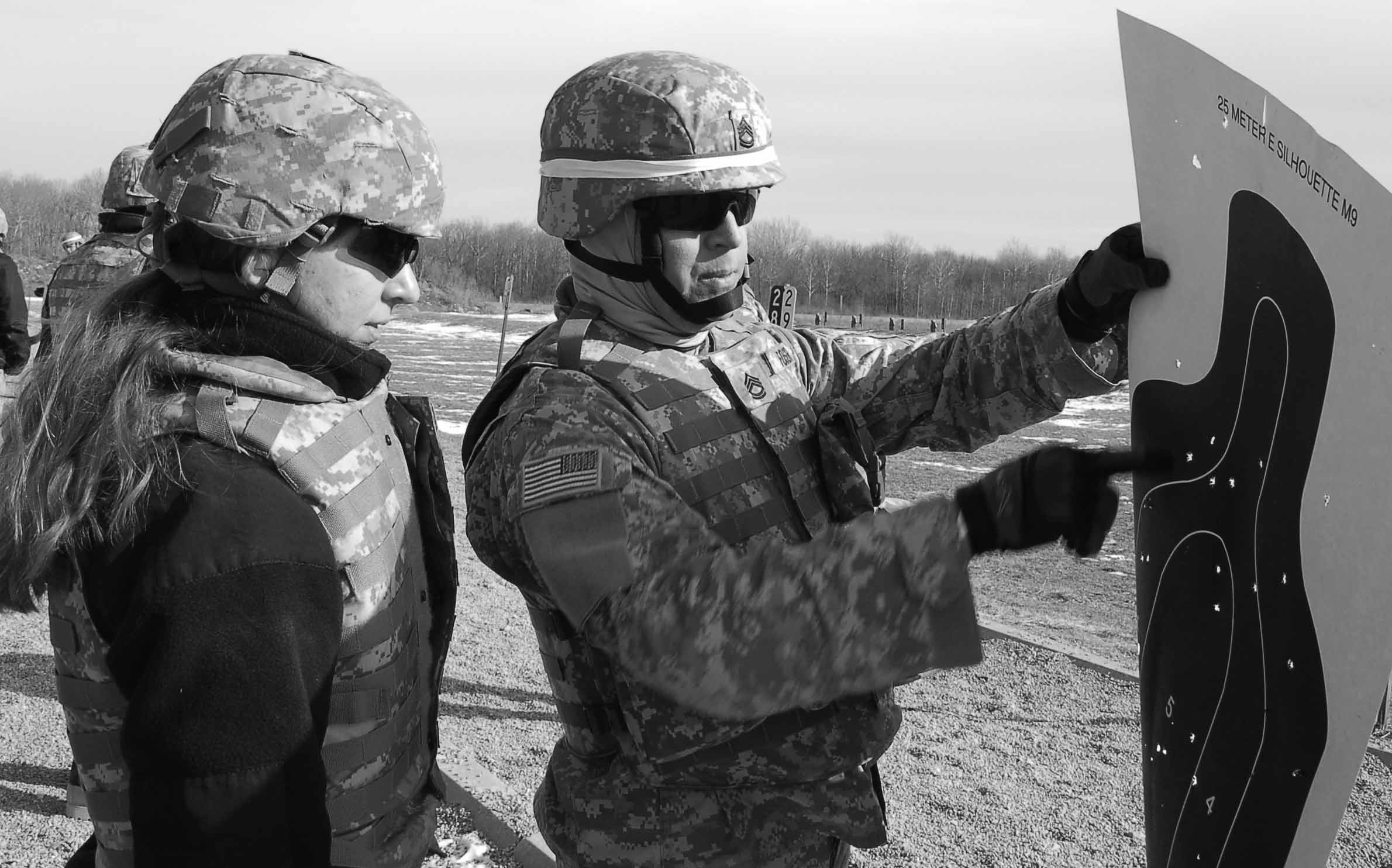
CAMP ATTERBURY JOINT MANEUVER TRAINING CENTER, Ind. (Army News Service, Feb. 18, 2010) -- The first iteration of a new course designed to better equip Department of Defense civilians for deployment wrapped up here Feb. 3.
The 10-day course prepared 16 students to begin work as part of the Civilian Expeditionary Workforce. The CEW is a workforce of Department of Defense civilians trained and equipped to deploy oversees in support of worldwide military missions. Those who graduated in the first class are deploying to Iraq, Afghanistan and the Horn of Africa.
Brig. Gen. Clif Tooley, Commanding General for Camp Atterbury-Muscatatuck
Center for Complex Operations, said the CEW members volunteer to be put in a
status that makes them subject to be deployed on a short-term basis for up
to two years.
"This gives the DOD flexibility in meeting emerging requirements," he said.
Whether they have logistics jobs or intelligence positions, the students' main goal while training at Camp Atterbury and Muscatatuck Urban Training Centers was not to perfect their profession, but to learn how to do their duties in a new and potentially stressful environment.
"Our purpose is to help prepare our civilians to be at peak performance on day-one in theater," said Marilee Fitzgerald, the Pentagon's acting deputy under secretary of defense for civilian personnel policy. "Many of our deployers are leaving desk jobs and going to the deployment zone."
Fitzgerald said that the training helps to build an understanding of the environment in which the civilians will be working. She said the objectives of the training are to strengthen emotional resilience; understand the tools and methods for making effective decisions in uncertain chaotic environments; understand the principles of conflict transformation toward understanding social dynamics in conflict environments; enhance ability to interact and solve problems across different cultures, languages and governments; and provide tools for dealing with the challenges of post deployment integration.
The course was developed through a partnership between Fitzgerald's office, the Office of the Deputy Under Secretary of Defense for Readiness and the Indiana Army National Guard. Frank DiGiovanni, the deputy director for readiness and training programs and policy, said the customized set of course curriculum was derived from several ongoing training initiatives across the department managed by his office.
"This curriculum is on the cutting edge of several new approaches for training our personnel for deployment," he said. DiGiovanni said lessons learned here will help formulate training policy across the entire department.
DiGiovanni also said that the trend lines are showing that the department will look to the Department of Defense's civilian force to make greater contributions in the future and that a trained and ready total force is definitely a force multiplier for current and future operations.
During the course of instruction, the students learned about national and military security strategy, conflict assessment, and post-traumatic stress disorder prevention. Students also participated in an immersive field training exercise, including attacks by insurgents, among other things.
The students' orientation packet hinted at the "austere" environment they would endure the last three days of training, and some students had no idea what they were in store for. After a grueling workday during which students moved between various mobilization stations, to include immunizations, the students left the "luxury" of their barracks and headed to Forward Operating Base Panther.
Civilian participant Julia Schoenfeld described her new weekend get-away.
"It's port-a-johns, it's a trailer -- but heated so that's good -- and you have to walk 10 minutes through the snow to brush your teeth," she said with a half smile. "It's not something we're used to."
And that's the point, as the acting deputy under secretary put it.
"By exposing them to those kinds of conditions it better prepares them to contribute on day-one," Fitzgerald said, explaining that familiarization is key to mission success.
"I think many of them who have not been deployed before feel a little more comfortable about the living and working conditions that they will have," Fitzgerald said.
Schoenfeld, who is with Joint Forces Command in Norfolk, Va., is deploying to Afghanistan to work with the International Security Assistance Force as a NATO advisor. Her training experience so far, she said, has been fun.
"It feels like we're sort of peeking into their world a little bit," Schoenfeld said. "The 8 immunization shots that I got yesterday, that's maybe not a fun view. But getting out on the range, learning how to shoot a pistol and an M-16, that's the fun part, even though it is the end of January."
Twenty-five degree weather notwithstanding, the civilians braved the brisk Indiana winter to learn the ins and outs of surviving the wilderness of a new nation.
"I think [the training] helps us not be such a liability to our military counterparts," Schoenfeld said. "We're self-sufficient when we get there. It's not motor memory yet but at least we're familiar with a lot of the procedures and how to keep ourselves safe and not harm everybody else."
David Matthews, who will be deploying to Afghanistan as a senior strategic planning officer, said although theirs is the first class to go through the process, it was incredibly well organized.
"The quality of the instruction is superb," Matthews said. "It has met the needs of someone who is going into country for the first time."
Matthews said although the training the CEW goes through is not job specific, it excels at being safety specific.
"The training here prepares me for going overseas and being inculcated in the culture and dealing with safety and things of that nature," he said, explaining that the instructors aim to increase the civilians' awareness.
"Are you culturally sensitive' Do you know what your resources are when you're in theater' Do you know how to ride in a Humvee' Do you know how to handle a weapon' [They teach] things of that nature. That's something that everyone that's going into theater needs," he said. "So in that respect it's a wonderful program."
For Matthews, the desert deployment is not the first although he said he is eager to work with the military again.
While Schoenfeld visited Afghanistan in 2008 this will be her first real deployment and she -- and most of the other civilians, she believes -- accepted the mission with a certain amount of pride.
"I think for the DOD civilian it is really hard to find a way to serve your country in the same way that the armed forces get to," she said. "I think for most of us here, it's a commitment to serve. It's a once in a lifetime experience that you'll never forget."
Fitzgerald agreed that the civilian workers share the same passion as their combat brethren.
"It is a proud moment when the DOD civilians can serve alongside their warfighters," she said.
To date, more than 3,000 civilians have deployed in support of overseas stabilization missions.
(T.D. Jackson writes for Camp Atterbury Public Affairs. Eileen M. Lainez contributed to the article.)

Social Sharing